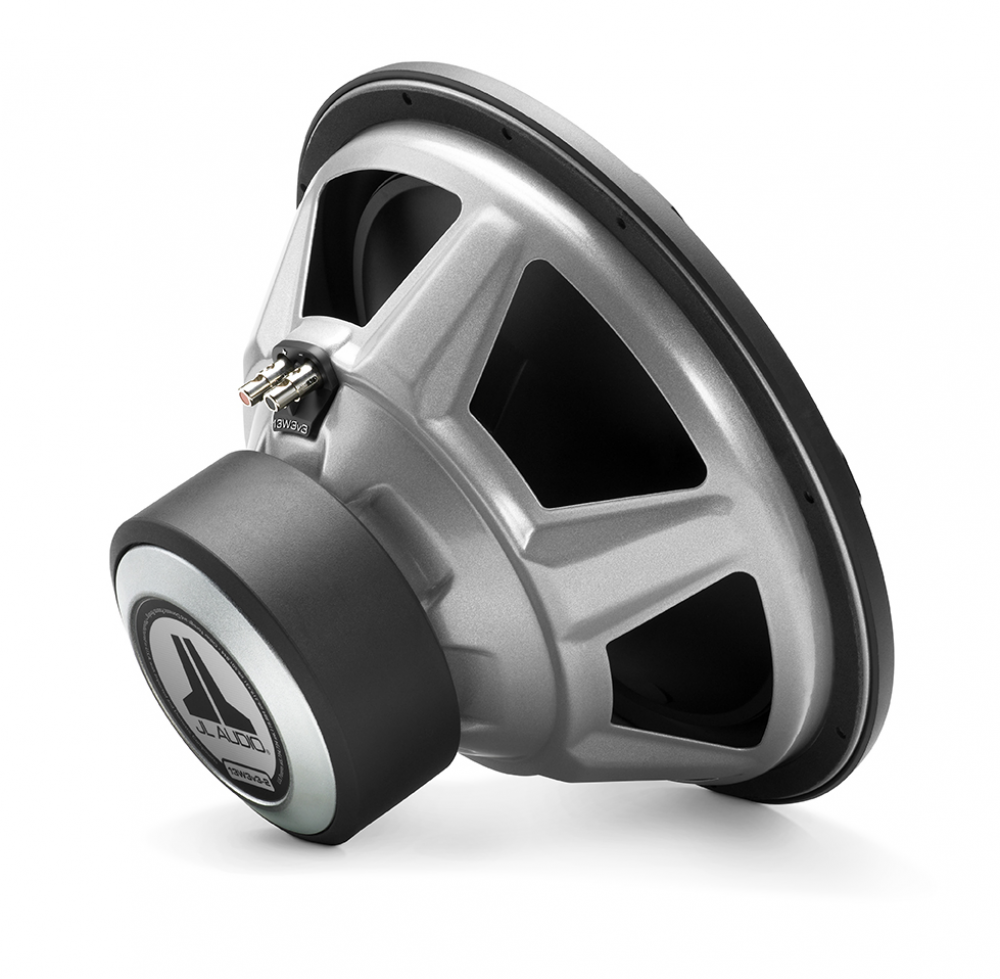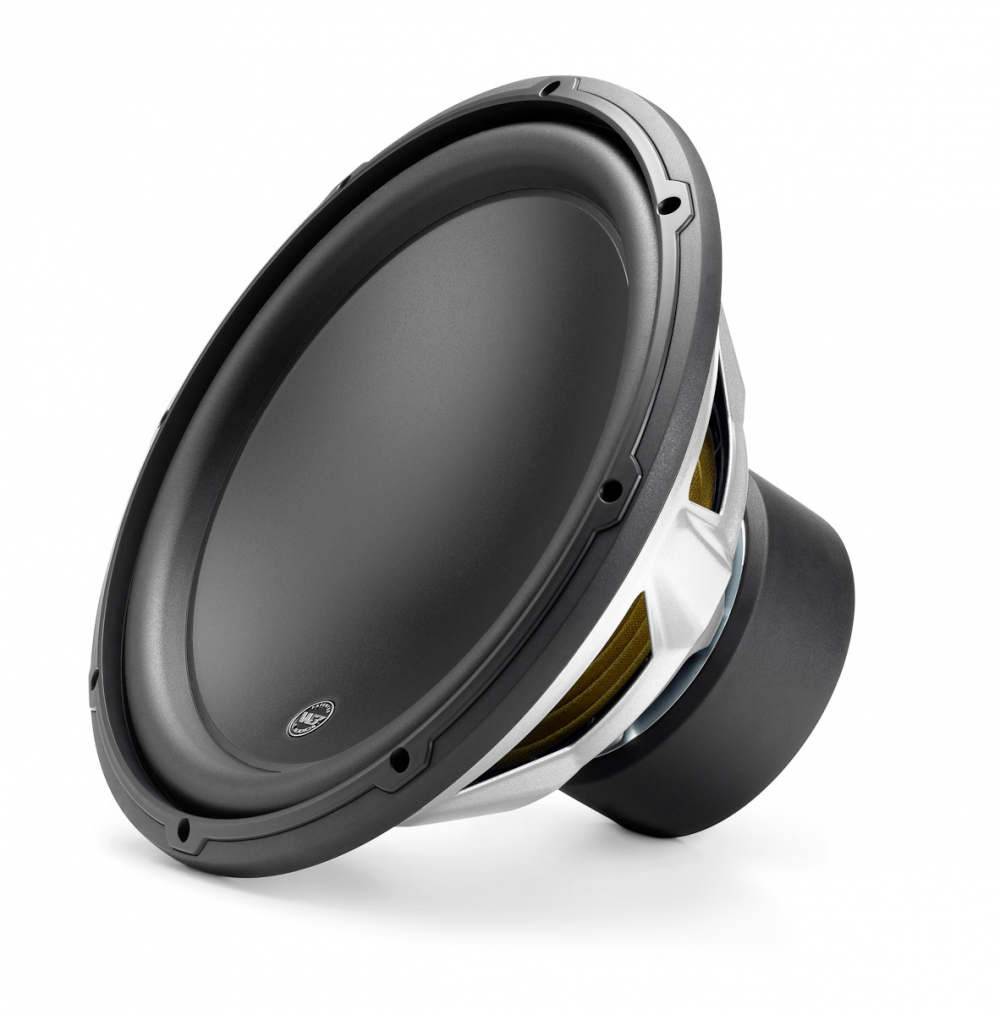



Особо высокие требования к мощности и глубине низкочастотного регистра могут быть вызваны крупными размерами автомобиля, личными предпочтениями, либо спецификой инсталляционного проекта. В любом случае, крупноразмерный 13W3v3 просто создан для таких непростых задач! Большая площадь диффузора приносит ощутимую прибавку в глубине баса и эффективности (чувствительности), тогда как допустимая мощность также повышена до 600 Вт (RMS, продолжительная). Но прежде всего это источник глубокого баса с предельно высоким качеством звучания. Точность, полнота и динамика нижнего регистра в исполнении 13W3v3 превосходят самые смелые ожидания, полностью отвечая стандартам более дорогостоящих классов аудиотехники. Такую репутацию сумело заслужить еще первое поколение серии W3, а нынешнее третье поколение v3 во всем превосходит своих знаменитых предшественников.
Конструкция подчинена хорошо известной для продукции JL Audio концепции: максимально длинноходная подвижная система (Xmax 15.5 мм) при сниженных требованиях к величине объема корпуса. Многие из применяемых эксклюзивных технологий получили свое рождение при создании наших флагманских сабвуферов, несравненных W7. Особо жесткий диффузор изготовлен из полипропилена с минеральным добавками, в мощной магнитной системе применяется тщательная оптимизация динамических параметров DMA, звуковая катушка крепится к диффузору и центрирующей шайбе через усиленный вентилируемый кольцевой адаптер VRC. Конструктивные решения не только приносят выдающееся качество звучания, но также способствуют исключительной надежности и стабильности характеристик, при самом жестком контроле качества каждого экземпляра продукции.
При выборе крупноразмерного сабвуфера следует уделить повышенное внимание планам компоновки багажного отсека. Помимо большого диаметра, НЧ-динамик требует более габаритного корпуса, чем привычные 250-мм (10") и 300-мм (12") модели. Рекомендуемые значения "чистого" объема корпуса (без учета вытесняемого конструкцией динамика объема Driver Displacement, внутренних распорок и прочих элементов конструкции корпуса) составляют: 42.5 л для закрытого корпуса и 63.7 л для корпуса с фазоинвертором.. Отсутствие центрального воздуховода в тыльной части, а также другие особенности конструкции, позволяют размещать динамик практически вплотную к внутренней задней стенке корпуса, для уменьшения габаритной глубины. Более подробные сведения по рекомендуемому акустическому оформлению можно найти в "Руководстве пользователя".
При желании можно приобрести защитный гриль SGRU-13 за дополнительную плату.

- Допустимая продолжительная мощность (RMS)
- 600 W
- Рекомендованная мощность усилителя (RMS)
- 150 - 600 W
- Номинальное сопротивление (Znom)
- 4 Ω
- Резонансная частота (Fs)
- 23.66 Hz
- Электрическая добротность (Qes)
- 0.465
- Механическая добротность (Qms)
- 6.774
- Полная добротность (Qts)
- 0.435
- Эквивалентный объем (Vas)
- 4.793 cu ft / 135.74 L
- Амплитуда линейных колебаний (Xmax)*
- 0.610 in / 15.5 mm
- Относительная эффективность системы (no)
- 0.37%
- Уровень чувствительности (1 Вт / 1 м)**
- 87.90 dB SPL
- Эффективная площадь диффузора (Sd)
- 103.850 sq in / 0.0670 sq m
- Номинальное сопротивление (Re)
- 3.569 Ω

- Номинальный диаметр
- 13.5 in / 345 mm
- Внешний диаметр (А)
- 14.0 in / 356 mm
- Диаметр монтажного отверстия (В)
- 12.5625 in / 319 mm
- Диаметр креплений (С)
- 13.2 in / 335 mm
- Внешний диаметр магнитной системы (D)
- 5.79 in / 147 mm
- Монтажная глубина (Е)
- 7.63 in / 194 mm
- Объем вытесняемый динамиком (Driver Displacement)
- 0.096 cu ft / 2.72 liters
- Вес
- 17.75 lb / 8.05 kg

- Толщина стенок
- 0.75 in / 19 mm
- Толщина передней панели
- 0.75 in / 19 mm
- Объем корпуса (без объема динамика)
- 2.25 cu ft / 63.7 L
- Ширина корпуса (внешняя, W)
- 21.75 in / 552 mm
- Высота корпуса (внешняя, H)
- 17 in / 432 mm
- Глубина корпуса (внешняя, D)
- 18 in / 457 mm
- Частота среза по уровню -3 дБ (F3)
- 35 Hz
- Резонансная частота в закрытом корпусе (Fc)
- 48.5 Hz
- Полная добротность акустической системы (Qtc)
- 0.89
- Толщина стенок
- 0.75 in / 19 mm
- Толщина передней панели
- 0.75 in / 19 mm
- Объем корпуса (без объема динамика)
- 2.25 cu ft / 63.7 L
- Ширина корпуса (внешняя, W)
- 21.75 in / 552 mm
- Высота корпуса (внешняя, H)
- 17 in / 432 mm
- Глубина корпуса (внешняя, D)
- 18 in / 457 mm
- Частота среза по уровню -3 дБ (F3)
- 35 Hz

- Ширина порта фазоинвертора (внутренняя, SW)
- 1.5 in / 38 mm
- Высота порта фазоинвертора (внутренняя, SH)
- 15.5 in / 394 mm
- Длина порта фазоинвертора (внутренняя, SL)
- 34.375 in / 873 mm
- Длина угловой части порта фазоинвертора (EL)
- 15.625 in / 397 mm
- Частота настройки фазоинвертора (Fb)
- 27 Hz
Dynamic Motor Analysis (DMA) – динамический анализ для оптимизации магнитной системы громкоговорителя

Dynamic Motor Analysis (DMA) – динамический анализ для оптимизации магнитной системы громкоговорителя
Суть вопроса:
Система Dynamic Motor Analysis (DMA) представляет собой мощное программное обеспечение, моделирующее электромагнитные процессы по методу конечных элементов (Finite Element Analysis – FEA) разработанное и впервые представленное JL Audio в 1997, чтобы научно решить проблему линейности динамиков. Использование усовершенствованной с годами системы DMA при проектировании динамиков позволяет значительно снизить искажения и улучшить переходные характеристики… или, проще говоря, получить плотный, неискажённый артикулированный бас.
Подробная информация:
Начиная с 1997 года JL Audio является лидирующей компанией, разрабатывающей элементы подвеса и магнитной системы динамиков с использованием моделирования по методу конечных элементов. Целью этих исследований является расшифровка “геномома громкоговорителя”, понимание и оценка его реального поведения в движении при подаче на динамик реального сигнала определённой мощности. Основным компонентом этой интегрированной системы моделирования является DMA (Dynamic Motor Analysis). Начиная с модели 15W3 и сабвуферов серии W7 в конце 1990-х и начале 2000 х годов, анализ DMA сыграл важную роль в формировании дизайна всех громкоговорителей JL Audio, включая наши компонентные акустические системы.
DMA – это система анализа на основе метода конечных элементов (Finite Element Analysis – FEA), это означает, что она берёт большую комплексную задачу, разбивает ее на небольшие элементы для анализа, а затем собирает данные для формирования “общей картины” точного решения. Технологический прорыв DMA заключается в том, что он фактически учитывает взаимное влияние подводимого к катушке мощного сигнала и положение катушки/диффузора динамика в рамках анализа во временной области. Это дает нам очень точную модель фактического поведения динамика при подаче на него сигнала с реальной мощностью, чего не могут сделать традиционный метод Тиля-Смолла или другие измерения параметров на низкой мощности. Поскольку DMA анализирует не стационарную модель, можно изменять параметры схемы в поисках оптимальных параметров. Процесс моделирования происходит в течение длительного периода времени для каждого динамика.
DMA способен анализировать реальные эффекты колебания мощности и при перемещении катушки относительно магнитной системы динамика, в частности динамические изменения “фиксированного” магнитного поля. Это дает чрезвычайно ценную информацию по сравнению с традиционным моделированием, которое для простоты расчета предполагает, что так называемое “фиксированное” магнитное поле, создаваемое в зазоре звуковой катушки неизменно. DMA не только показывает, что это “фиксированное” поле на самом деле изменяется из-за влияния магнитного поля, создаваемого током, протекающим через звуковую катушку, но и помогает нашим инженерам найти решения, которые минимизируют эту нестабильность. Анализ этого поведения имеет решающее значение для понимания механизмов возникновения нелинейных искажений в моторе динамика и проливает свет на аспекты конструкции магнитной системы, которые определяют его линейность:
- Линейность силы магнитной системы в рабочем диапазоне перемещения подвижной системы громкоговорителя
- Постоянство силы магнитной системы с обоими величинами тока проходящего через звуковую катушку – положительной и отрицательной
- Постоянство сила магнитной системы при различных уровнях мощности подводимого сигнала
Применение системы DMA позволяет нашим инженерам электроакустикам вносить критические изменения в конструкцию и создавать динамики с линейными и высокостабильными магнитными системами.
Любой динамик произведенный компанией JL Audio обладает пониженным уровнем искажений, улучшенными переходными характеристиками и превосходным качеством звучания.
Elevated Frame Cooling (U.S. Patent #6,219,431 & #6,229,902)

Elevated Frame Cooling (U.S. Patent #6,219,431 & #6,229,902)
Summary:
JL Audio's patented Elevated Frame Cooling design delivers cool air through slots directly above the top-plate to the voice coil of the speaker. This not only enhances power handling, but also sound quality by minimizing dynamic parameter shifts and power compression.
Detailed Information:
Many speakers employ venting techniques to enhance voice coil cooling. This is typically accomplished by having big holes in the sides of the frame just below the spider attachment shelf. While it provides a modest cooling benefit, this low-velocity air-flow does not blow directly or strongly on the voice coil.
Our patented design improves upon this cooling technique in a number of ways. By elevating the frame above the top-plate of the motor (via stand-offs integrated into the bottom of the frame) a narrow, high-velocity air-path is created between the bottom surface of the frame and the top surface of the top-plate. This air path leads directly to the voice coil and then turns upward into the spider air cavity. By utilizing the pumping action of the spider through this focused air path, a large volume of cool air hits the coil windings directly.
Another important benefit is that the upper surface of the top-plate (one of the speaker's hottest parts) is directly exposed to cooling air flow, whereas on a conventional design it is isolated from the air flow by the lower flange of the frame. The elevated frame technology greatly increases thermal power handling, reduces compression effects and does so without any additional parts.
Floating Cone Attach Method - FCAM™ (U.S. Patent #6,501,844)

Floating Cone Attach Method - FCAM™ (U.S. Patent #6,501,844)
Summary:
This assembly technique, conceived by JL Audio, ensures proper surround geometry in the assembled speaker for better excursion control and dynamic voice coil alignment.
Detailed Information:
JL Audio's patented FCAM™ technology is an innovative method of bonding the surround/cone assembly to the voice coil former/spider assembly. This feature helps ensure concentricity of the surround, spider and voice coil without torquing the suspension to achieve it. This allows for the inevitable, slight variations in production part dimensions without having them negatively impact the integrity of the suspension and coil-centering at high excursions.
Vented Reinforcement Collar (U.S. Patent #5,734,734)

Vented Reinforcement Collar (U.S. Patent #5,734,734)
Summary:
JL Audio's patented Vented Reinforcement Collar (VRC®) improves the rigidity and stability of the cone/spider/voice coil junction and directs airflow over the voice coil windings for improved thermal performance.
Detailed Information:
The Vented Reinforcement Collar (VRC®) is a composite structure that addresses two issues related to reliability.
By reinforcing the critical junction between the cone, voice coil and spider, the VRC greatly reduces failures due to glue breakdown or material weakness. It does this by greatly increasing adhesive contact area and providing stress relief to the spider material at excursion extremes.

The VRC™ also features slots that facilitate air flow directly onto the voice coil windings. This reduces thermal compression effects and enhances reliability.
Current versions of the VRC™ also incorporate lead-wire strain relief structures to improve mechanical reliability.
Insert Molded Suspension / Coil / Terminal Sub-Assembly (U.S. Patent #7,379,558)

Insert Molded Suspension / Coil / Terminal Sub-Assembly (U.S. Patent #7,379,558)
Summary:
Spiders, voice coils, terminals and lead wires are preassembled, using a patent-pending process, onto a composite carrier for improved precision and reliability.
Detailed Information:
A conventional speaker is assembled in layers. In other words, multiple parts are assembled and glued sequentially into the basket, leading to stacking of tolerances and making it difficult to achieve optimal assembly precision.
JL Audio's patent-pending insert-molded spider carrier permanently bonds the spider to a mechanically robust carrier that also incorporates the terminal assembly and lead wire strain relief features for enhanced reliability and optimal alignment of parts. This subassembly is assembled outside the speaker basket, for optimum alignment and glue-joint integrity. The benefit is a more precisely built, more mechanically sound loudspeaker.
Customizable Trim Ring (U.S. Patent #D480,709)

Customizable Trim Ring (U.S. Patent #D480,709)
Summary:
This removable ring can be painted to match the installation theme and directly receives JL Audio grille mesh inserts (sold separately).
Detailed Information:
This ABS trim ring is molded in black, but that doesn't mean it has to stay that way. By custom painting it, you can match your installation theme and create a personalized look.
Specifically-designed grille mesh inserts are available separately and fit into the inner diameter of the trim ring.
Helpful Tip: Installing the grille mesh inserts is much easier before mounting the woofer into the enclosure.
Engineered Lead-Wire System (U.S. Patent #7,356,157)

Engineered Lead-Wire System (U.S. Patent #7,356,157)
Summary:
Carefully engineered lead-wire design and attachments ensure controlled, quiet lead-wire behavior under the most extreme excursion demands.
Detailed Information:
Managing the lead-wires on a long-excursion woofer is one of the trickier aspects of its mechanical design. To address this, many long-excursion woofers today rely on a simple solution that weaves the lead-wires into the spider (rear suspension) of the driver.
The biggest problem with this approach is that spider limiting behavior plays a hugely important role a woofer's performance. Lead-wires that are attached or woven into the spider material can alter the spider's "stretching" behavior. The tinsel wire naturally has less 'give' than the fabric material of the spider leading to asymmetrical spider behavior and non-uniform stress distribution around the spider circumference. The wire attachment points can also cause localized pulling and tearing forces at the spider's excursion limits. As such, longevity becomes a major concern and makes the woven-in design less than ideal for very long-excursion designs.
While a traditional 'flying lead' design does not compromise spider linearity or radial stability, it creates its own challenges on a long-excursion woofer. Managing the 'whipping' behavior of the wire and making sure it does not contact the cone or spider is one challenge. Another is ensuring that the leads do not short one another or the frame of the woofer.
To overcome these issues, JL Audio's engineered flying lead-wires work in conjunction with carefully engineered entry and exit support structures molded into the terminals and the voice coil collar. Some models also feature jacketed lead-wires to further reduce the likelihood of shorting and fatigue. The result is flawless high-excursion lead-wire behavior, with outstanding reliability and none of the compromises inherent to a woven-in lead wire system. Building woofers this way requires much more labor and parts complexity than the simpler woven-in approach, but the payoff is in reduced distortion, reduced mechanical noise and improved reliability.
Precision Built in U.S.A.

Precision Built in U.S.A.
Summary:
JL Audio's Miramar, Florida loudspeaker production facility is one of the most advanced in the world.
Detailed Information:
At a time when most audio products are built overseas, JL Audio’s commitment to in-house loudspeaker production continues to grow. All W7’s, W6’s, TW5’s, TW3's, TW1's, W3v3’s and some of our ZR products. We also build our Marine Speaker Systems, Home Subwoofers, Stealthbox® products and the vast majority of our enclosed subwoofer systems in Florida.
To pull this off in a competitive world market, our production engineering team has created one of the world’s most advanced loudspeaker assembly facilities. This commitment to state-of-the-art technology allows our highly skilled workforce to efficiently build JL Audio products to extremely high quality standards.
While it is also feasible to build good quality products overseas (and we do build some of our products in Europe and Asia), it can be challenging when the product’s technology is innovative or complex. Since most of our premium loudspeakers incorporate proprietary, patented technologies requiring specific assembly techniques, we prefer that the people who design them have close access to the people manufacturing them.
